Yuqing Wang
Learning Generalizable Shape Completion with SIM(3) Equivariance
Sep 30, 2025Abstract:3D shape completion methods typically assume scans are pre-aligned to a canonical frame. This leaks pose and scale cues that networks may exploit to memorize absolute positions rather than inferring intrinsic geometry. When such alignment is absent in real data, performance collapses. We argue that robust generalization demands architectural equivariance to the similarity group, SIM(3), so the model remains agnostic to pose and scale. Following this principle, we introduce the first SIM(3)-equivariant shape completion network, whose modular layers successively canonicalize features, reason over similarity-invariant geometry, and restore the original frame. Under a de-biased evaluation protocol that removes the hidden cues, our model outperforms both equivariant and augmentation baselines on the PCN benchmark. It also sets new cross-domain records on real driving and indoor scans, lowering minimal matching distance on KITTI by 17% and Chamfer distance $\ell1$ on OmniObject3D by 14%. Perhaps surprisingly, ours under the stricter protocol still outperforms competitors under their biased settings. These results establish full SIM(3) equivariance as an effective route to truly generalizable shape completion. Project page: https://sime-completion.github.io.
Understand Before You Generate: Self-Guided Training for Autoregressive Image Generation
Sep 18, 2025Abstract:Recent studies have demonstrated the importance of high-quality visual representations in image generation and have highlighted the limitations of generative models in image understanding. As a generative paradigm originally designed for natural language, autoregressive models face similar challenges. In this work, we present the first systematic investigation into the mechanisms of applying the next-token prediction paradigm to the visual domain. We identify three key properties that hinder the learning of high-level visual semantics: local and conditional dependence, inter-step semantic inconsistency, and spatial invariance deficiency. We show that these issues can be effectively addressed by introducing self-supervised objectives during training, leading to a novel training framework, Self-guided Training for AutoRegressive models (ST-AR). Without relying on pre-trained representation models, ST-AR significantly enhances the image understanding ability of autoregressive models and leads to improved generation quality. Specifically, ST-AR brings approximately 42% FID improvement for LlamaGen-L and 49% FID improvement for LlamaGen-XL, while maintaining the same sampling strategy.
GoT-R1: Unleashing Reasoning Capability of MLLM for Visual Generation with Reinforcement Learning
May 22, 2025Abstract:Visual generation models have made remarkable progress in creating realistic images from text prompts, yet struggle with complex prompts that specify multiple objects with precise spatial relationships and attributes. Effective handling of such prompts requires explicit reasoning about the semantic content and spatial layout. We present GoT-R1, a framework that applies reinforcement learning to enhance semantic-spatial reasoning in visual generation. Building upon the Generation Chain-of-Thought approach, GoT-R1 enables models to autonomously discover effective reasoning strategies beyond predefined templates through carefully designed reinforcement learning. To achieve this, we propose a dual-stage multi-dimensional reward framework that leverages MLLMs to evaluate both the reasoning process and final output, enabling effective supervision across the entire generation pipeline. The reward system assesses semantic alignment, spatial accuracy, and visual quality in a unified approach. Experimental results demonstrate significant improvements on T2I-CompBench benchmark, particularly in compositional tasks involving precise spatial relationships and attribute binding. GoT-R1 advances the state-of-the-art in image generation by successfully transferring sophisticated reasoning capabilities to the visual generation domain. To facilitate future research, we make our code and pretrained models publicly available at https://github.com/gogoduan/GoT-R1.
Insights into DeepSeek-V3: Scaling Challenges and Reflections on Hardware for AI Architectures
May 14, 2025

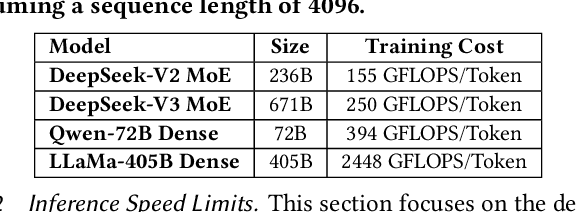
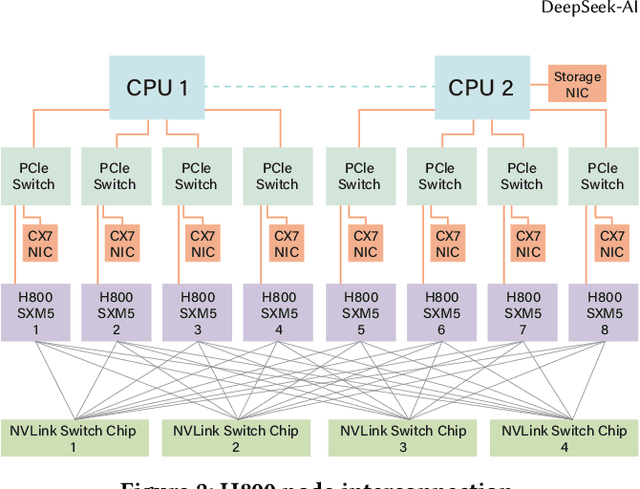
Abstract:The rapid scaling of large language models (LLMs) has unveiled critical limitations in current hardware architectures, including constraints in memory capacity, computational efficiency, and interconnection bandwidth. DeepSeek-V3, trained on 2,048 NVIDIA H800 GPUs, demonstrates how hardware-aware model co-design can effectively address these challenges, enabling cost-efficient training and inference at scale. This paper presents an in-depth analysis of the DeepSeek-V3/R1 model architecture and its AI infrastructure, highlighting key innovations such as Multi-head Latent Attention (MLA) for enhanced memory efficiency, Mixture of Experts (MoE) architectures for optimized computation-communication trade-offs, FP8 mixed-precision training to unlock the full potential of hardware capabilities, and a Multi-Plane Network Topology to minimize cluster-level network overhead. Building on the hardware bottlenecks encountered during DeepSeek-V3's development, we engage in a broader discussion with academic and industry peers on potential future hardware directions, including precise low-precision computation units, scale-up and scale-out convergence, and innovations in low-latency communication fabrics. These insights underscore the critical role of hardware and model co-design in meeting the escalating demands of AI workloads, offering a practical blueprint for innovation in next-generation AI systems.
Segment Any RGB-Thermal Model with Language-aided Distillation
May 04, 2025Abstract:The recent Segment Anything Model (SAM) demonstrates strong instance segmentation performance across various downstream tasks. However, SAM is trained solely on RGB data, limiting its direct applicability to RGB-thermal (RGB-T) semantic segmentation. Given that RGB-T provides a robust solution for scene understanding in adverse weather and lighting conditions, such as low light and overexposure, we propose a novel framework, SARTM, which customizes the powerful SAM for RGB-T semantic segmentation. Our key idea is to unleash the potential of SAM while introduce semantic understanding modules for RGB-T data pairs. Specifically, our framework first involves fine tuning the original SAM by adding extra LoRA layers, aiming at preserving SAM's strong generalization and segmentation capabilities for downstream tasks. Secondly, we introduce language information as guidance for training our SARTM. To address cross-modal inconsistencies, we introduce a Cross-Modal Knowledge Distillation(CMKD) module that effectively achieves modality adaptation while maintaining its generalization capabilities. This semantic module enables the minimization of modality gaps and alleviates semantic ambiguity, facilitating the combination of any modality under any visual conditions. Furthermore, we enhance the segmentation performance by adjusting the segmentation head of SAM and incorporating an auxiliary semantic segmentation head, which integrates multi-scale features for effective fusion. Extensive experiments are conducted across three multi-modal RGBT semantic segmentation benchmarks: MFNET, PST900, and FMB. Both quantitative and qualitative results consistently demonstrate that the proposed SARTM significantly outperforms state-of-the-art approaches across a variety of conditions.
SELC: Self-Supervised Efficient Local Correspondence Learning for Low Quality Images
Apr 06, 2025
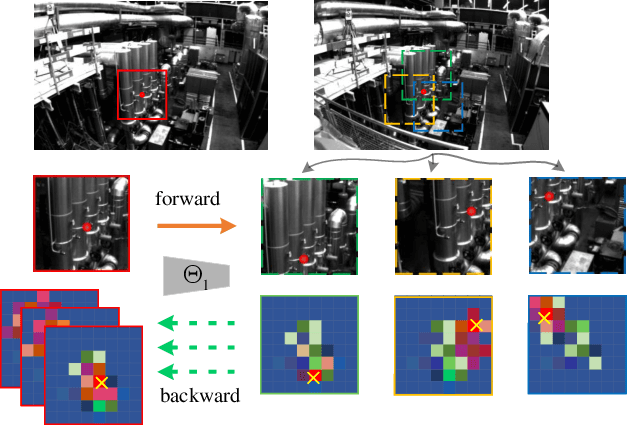

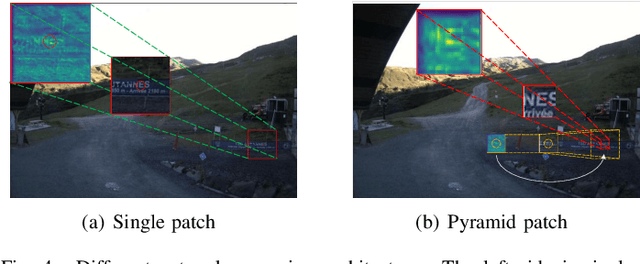
Abstract:Accurate and stable feature matching is critical for computer vision tasks, particularly in applications such as Simultaneous Localization and Mapping (SLAM). While recent learning-based feature matching methods have demonstrated promising performance in challenging spatiotemporal scenarios, they still face inherent trade-offs between accuracy and computational efficiency in specific settings. In this paper, we propose a lightweight feature matching network designed to establish sparse, stable, and consistent correspondence between multiple frames. The proposed method eliminates the dependency on manual annotations during training and mitigates feature drift through a hybrid self-supervised paradigm. Extensive experiments validate three key advantages: (1) Our method operates without dependency on external prior knowledge and seamlessly incorporates its hybrid training mechanism into original datasets. (2) Benchmarked against state-of-the-art deep learning-based methods, our approach maintains equivalent computational efficiency at low-resolution scales while achieving a 2-10x improvement in computational efficiency for high-resolution inputs. (3) Comparative evaluations demonstrate that the proposed hybrid self-supervised scheme effectively mitigates feature drift in long-term tracking while maintaining consistent representation across image sequences.
Bridging Continuous and Discrete Tokens for Autoregressive Visual Generation
Mar 20, 2025Abstract:Autoregressive visual generation models typically rely on tokenizers to compress images into tokens that can be predicted sequentially. A fundamental dilemma exists in token representation: discrete tokens enable straightforward modeling with standard cross-entropy loss, but suffer from information loss and tokenizer training instability; continuous tokens better preserve visual details, but require complex distribution modeling, complicating the generation pipeline. In this paper, we propose TokenBridge, which bridges this gap by maintaining the strong representation capacity of continuous tokens while preserving the modeling simplicity of discrete tokens. To achieve this, we decouple discretization from the tokenizer training process through post-training quantization that directly obtains discrete tokens from continuous representations. Specifically, we introduce a dimension-wise quantization strategy that independently discretizes each feature dimension, paired with a lightweight autoregressive prediction mechanism that efficiently model the resulting large token space. Extensive experiments show that our approach achieves reconstruction and generation quality on par with continuous methods while using standard categorical prediction. This work demonstrates that bridging discrete and continuous paradigms can effectively harness the strengths of both approaches, providing a promising direction for high-quality visual generation with simple autoregressive modeling. Project page: https://yuqingwang1029.github.io/TokenBridge.
Formation Control of Multi-agent System with Local Interaction and Artificial Potential Field
Mar 15, 2025



Abstract:A novel local interaction control method (LICM) is proposed in this paper to realize the formation control of multi-agent system (MAS). A local interaction leader follower (LILF) structure is provided by coupling the advantages of information consensus and leader follower frame, the agents can obtain the state information of the leader by interacting with their neighbours, which will reduce the communication overhead of the system and the dependence on a single node of the topology. In addition, the artificial potential field (APF) method is introduced to achieve obstacle avoidance and collision avoidance between agents. Inspired by the stress response of animals, a stress response mechanism-artificial potential field (SRM-APF) is proposed, which will be triggered when the local minimum problem of APF occurs. Ultimately, the simulation experiments of three formation shapes, including triangular formation, square formation and hexagonal formation, validate the effectiveness of the proposed method.
Parametric Point Cloud Completion for Polygonal Surface Reconstruction
Mar 11, 2025Abstract:Existing polygonal surface reconstruction methods heavily depend on input completeness and struggle with incomplete point clouds. We argue that while current point cloud completion techniques may recover missing points, they are not optimized for polygonal surface reconstruction, where the parametric representation of underlying surfaces remains overlooked. To address this gap, we introduce parametric completion, a novel paradigm for point cloud completion, which recovers parametric primitives instead of individual points to convey high-level geometric structures. Our presented approach, PaCo, enables high-quality polygonal surface reconstruction by leveraging plane proxies that encapsulate both plane parameters and inlier points, proving particularly effective in challenging scenarios with highly incomplete data. Comprehensive evaluations of our approach on the ABC dataset establish its effectiveness with superior performance and set a new standard for polygonal surface reconstruction from incomplete data. Project page: https://parametric-completion.github.io.
Cloud Computing Energy Consumption Prediction Based on Kernel Extreme Learning Machine Algorithm Improved by Vector Weighted Average Algorithm
Mar 06, 2025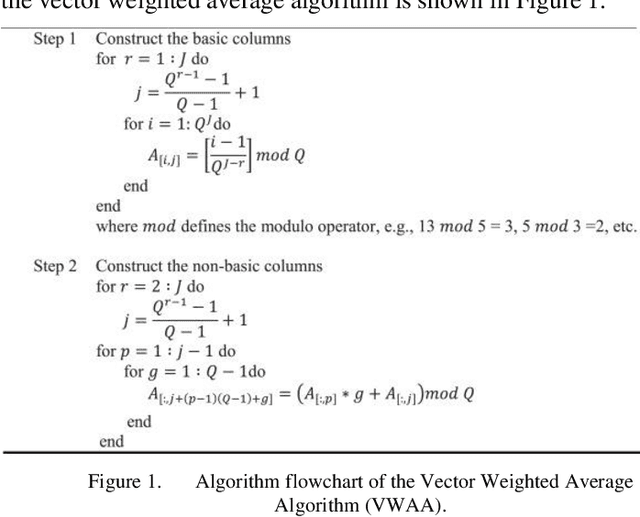
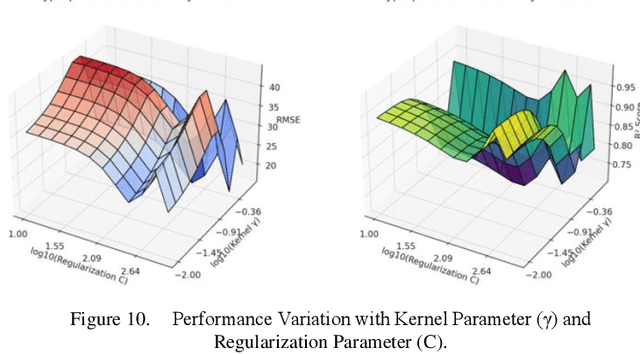
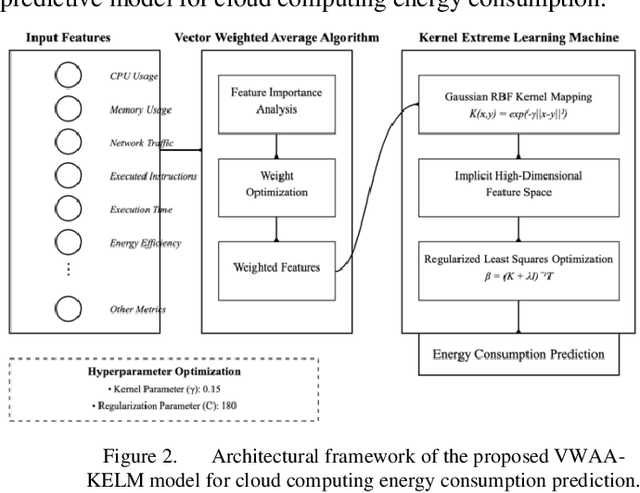
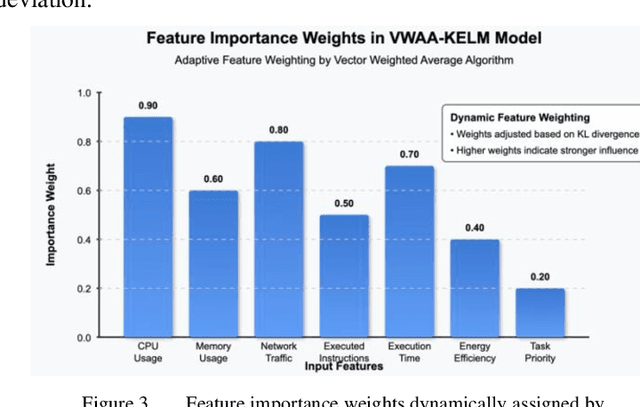
Abstract:With the rapid expansion of cloud computing infrastructure, energy consumption has become a critical challenge, driving the need for accurate and efficient prediction models. This study proposes a novel Vector Weighted Average Kernel Extreme Learning Machine (VWAA-KELM) model to enhance energy consumption prediction in cloud computing environments. By integrating a vector weighted average algorithm (VWAA) with kernel extreme learning machine (KELM), the proposed model dynamically adjusts feature weights and optimizes kernel functions, significantly improving prediction accuracy and generalization. Experimental results demonstrate the superior performance of VWAA-KELM: 94.7% of test set prediction errors fall within [0, 50] units, with only three cases exceeding 100 units, indicating strong stability. The model achieves a coefficient of determination (R2) of 0.987 in the training set (RMSE = 28.108, RPD = 8.872) and maintains excellent generalization with R2 = 0.973 in the test set (RMSE = 43.227, RPD = 6.202). Visual analysis confirms that predicted values closely align with actual energy consumption trends, avoiding overfitting while capturing nonlinear dependencies. A key innovation of this study is the introduction of adaptive feature weighting, allowing the model to dynamically assign importance to different input parameters, thereby enhancing high-dimensional data processing. This advancement provides a scalable and efficient approach for optimizing cloud data center energy consumption. Beyond cloud computing, the proposed hybrid framework has broader applications in Internet of Things (IoT) and edge computing, supporting real-time energy management and intelligent resource allocation.
 Add to Chrome
Add to Chrome Add to Firefox
Add to Firefox Add to Edge
Add to Edge